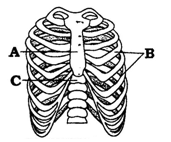Match the Column-I with Column-II:
Column-I Column-II
A. True ribs I. 3 pairs
B. False ribs II. 2 pairs
C. Floating ribs III. 7 pairs
(1) A - I, B - II, C - III
(2) A - III, B - I, C - II
(3) A - III, B - II, C - I
(4) A - II, B - I, C - III
Column-I Column-II
A. True ribs I. 3 pairs
B. False ribs II. 2 pairs
C. Floating ribs III. 7 pairs
(1) A - I, B - II, C - III
The figure is of rib cage. Identify A, B and C respectively:
(1) Coccyx, ribs, vertebral column
(2) Sternum, ribs, vertebral column
(3) Scapula, ribs, vertebral column
(4) Tarsal, ribs, vertebral column
Number of the bones in human appendicular skeleton is:
(1) 80
(2) 120
(3) 126
(4) 206
Number of bone in each upper limb is:
(1) 1, 1, 1
(2) 8, 5, 14
(3) 2, 2, 2, 16, 10, 28
(4) 1, 1, 1, 8, 5, 14
An acromion process is characteristically found in:
1. Pelvic girdle of mammals
2. Pectoral girdle of mammals
3. Skull bone
4. Vertebrae of mammals
The shoulder blade is large triangular bone situated in the dorsal part of the thorax between the 2nd and the 7th ribs. It is called:
(1) Clavicle
(2) Ilium
(3) Scapula
(4) Carplas
For articulation of head of humerus a depression found in scapula is called:
(1) Acetabulum
(2) Manubrium
(3) Occipital condyle
(4) Glenoid cavity
Which one of the following is the longest bone in human?
(1) Radius
(2) Tibia
(3) Femur (Thigh bone)
(4) Clavicle (Collar bone)
Acetabulum occurs in:
(1) Cranium
(2) Pectoral girdle
(3) Pelvic girdle
(4) Vertebrae
Pelvic girdle (hip girdle) is composed _________ coxal (hip) bones:
(1) 3
(2) 2
(3) 4
(4) 5







